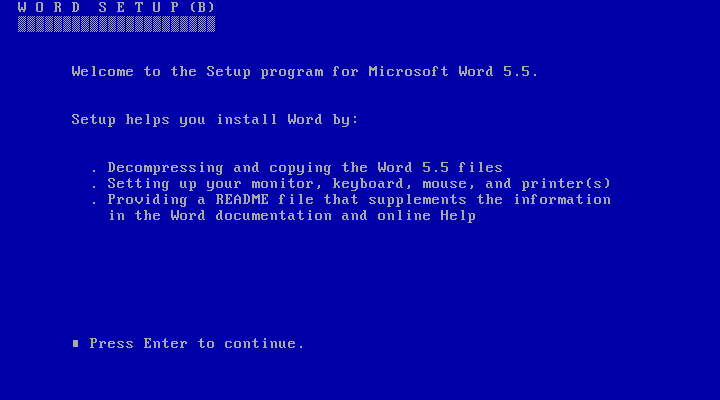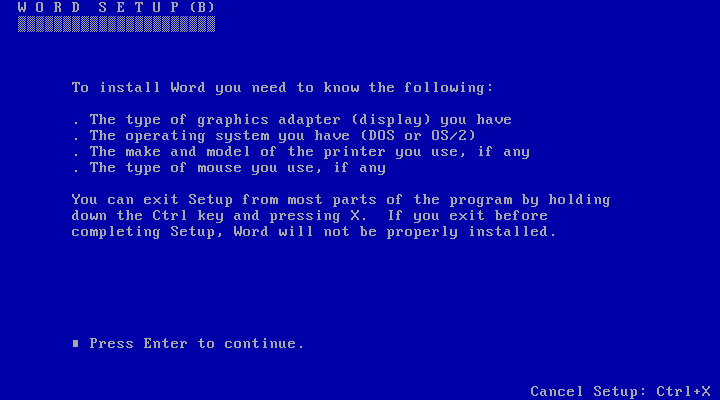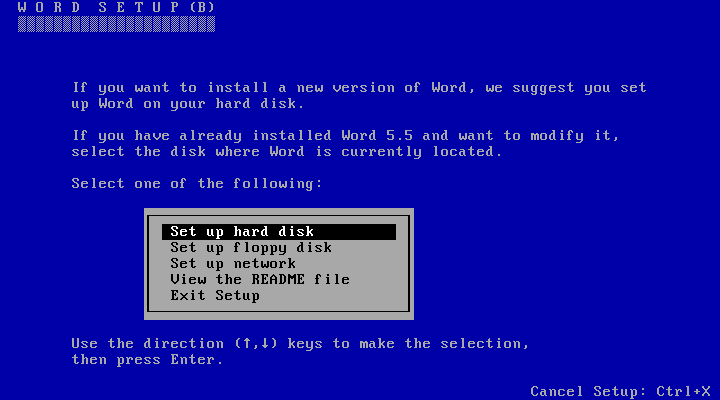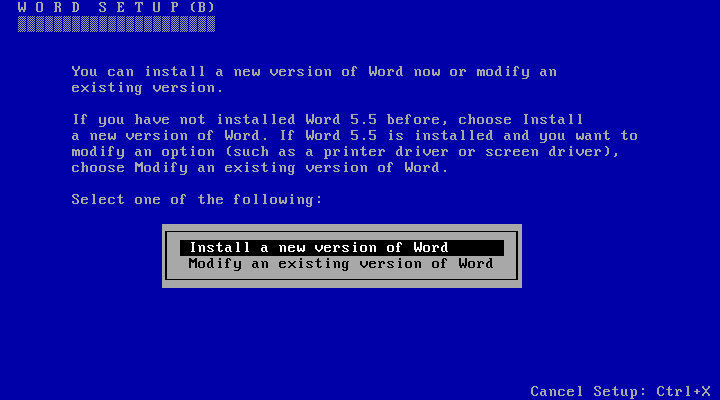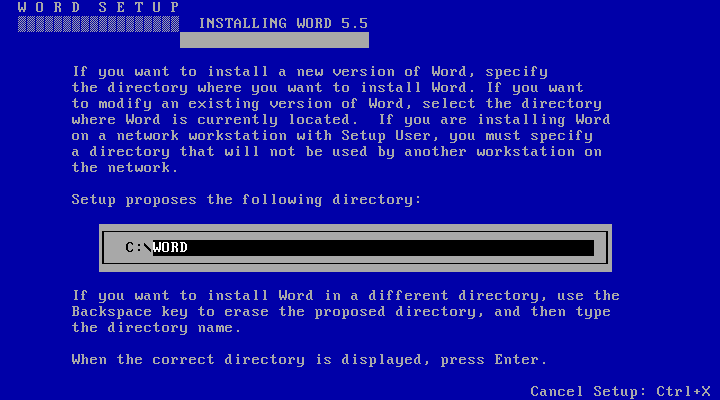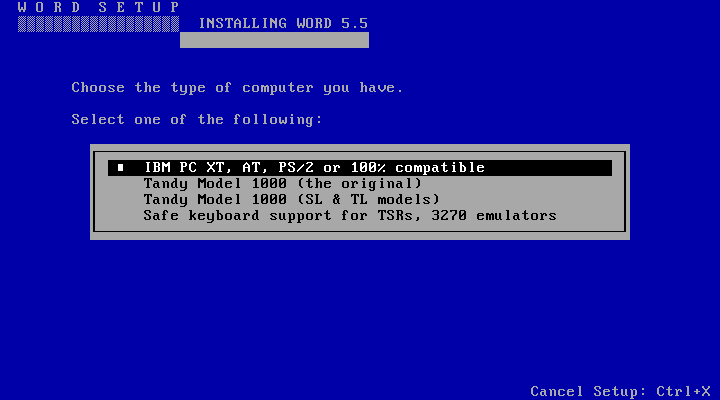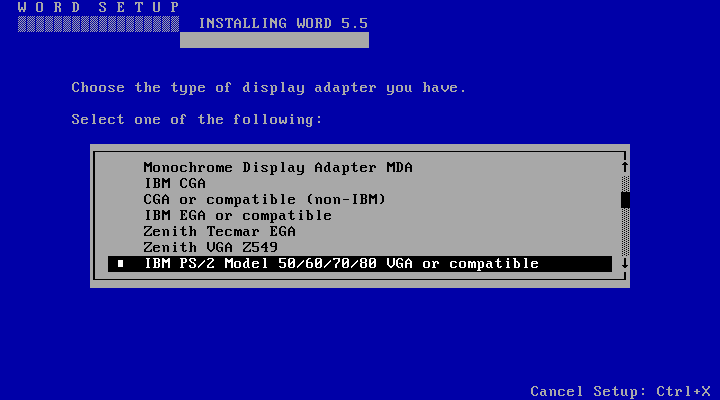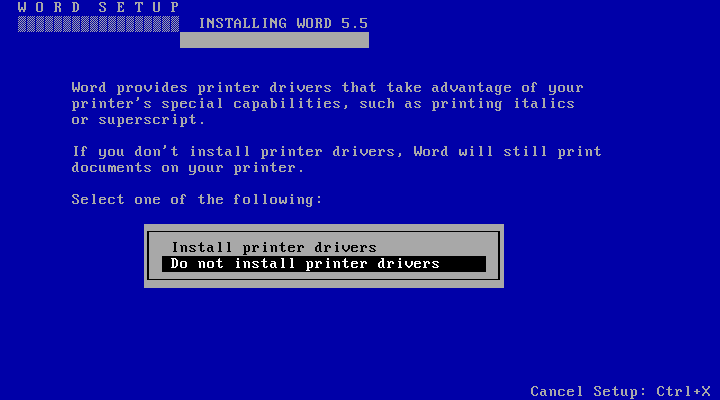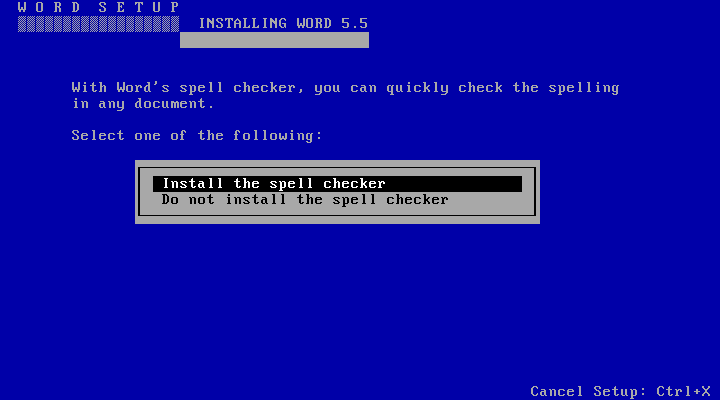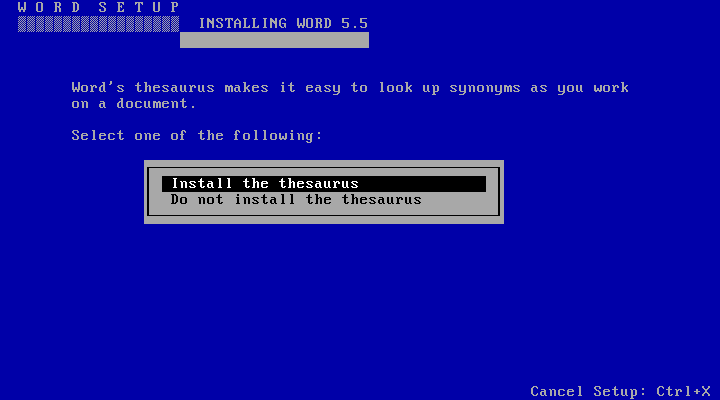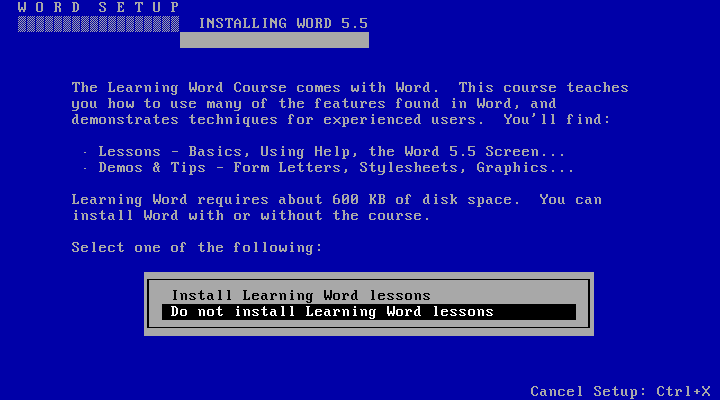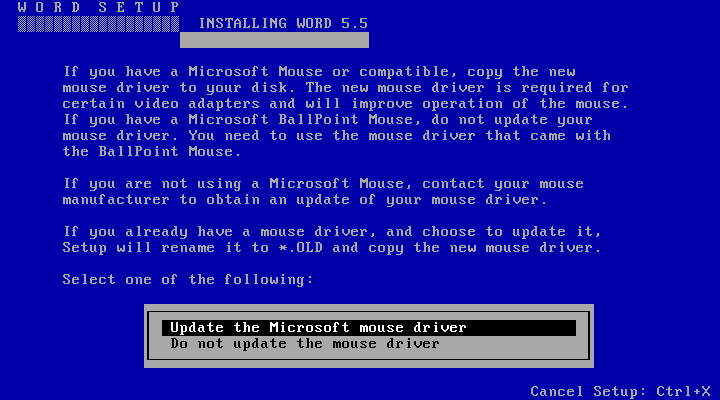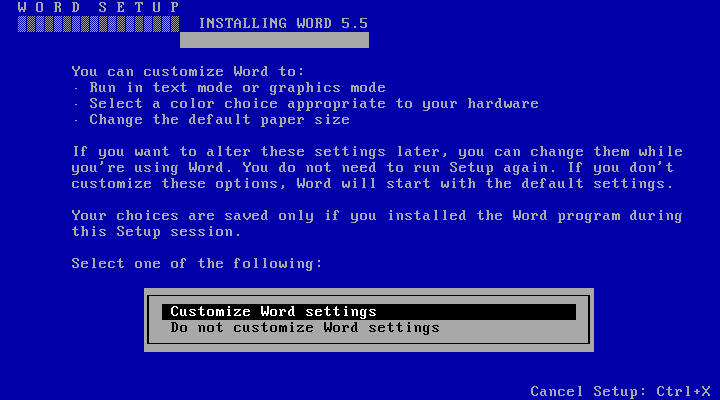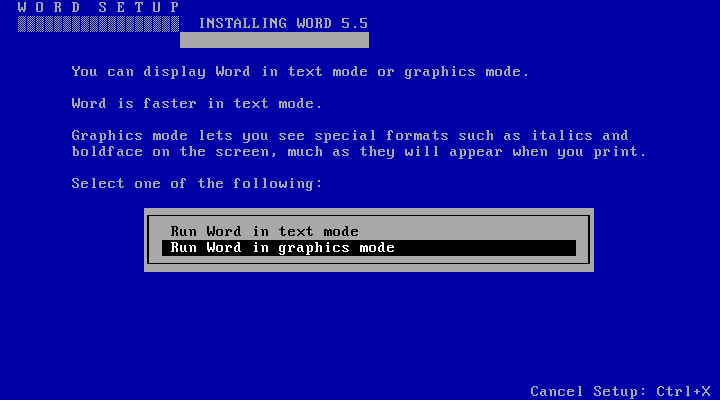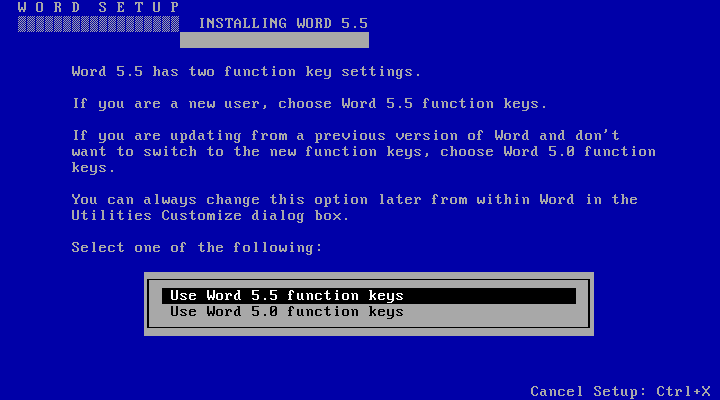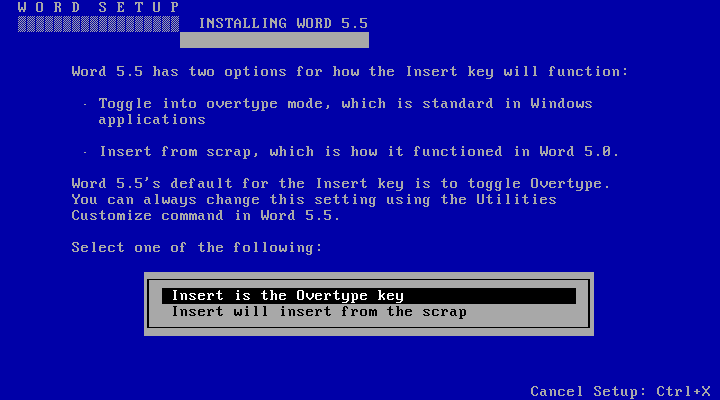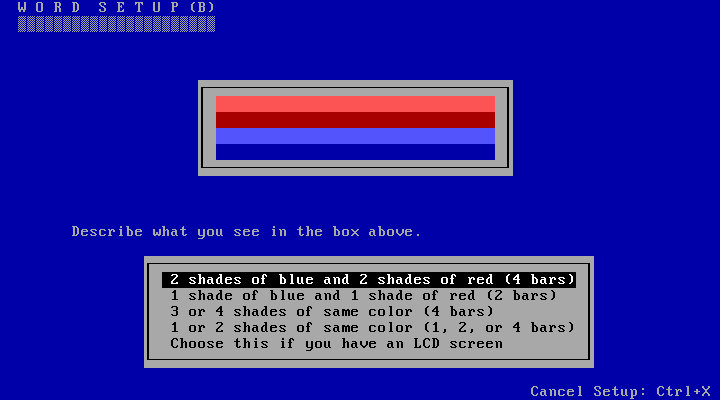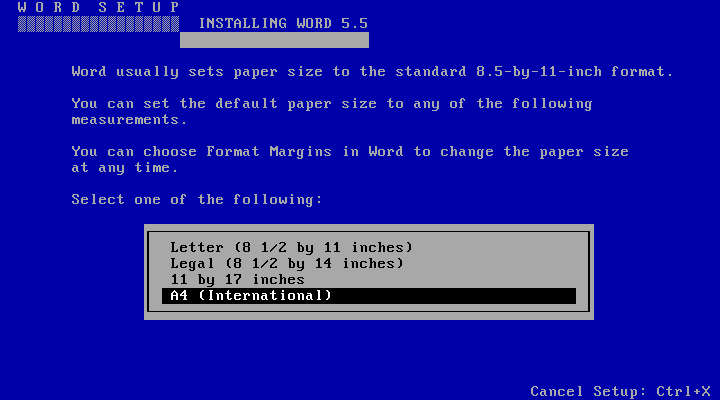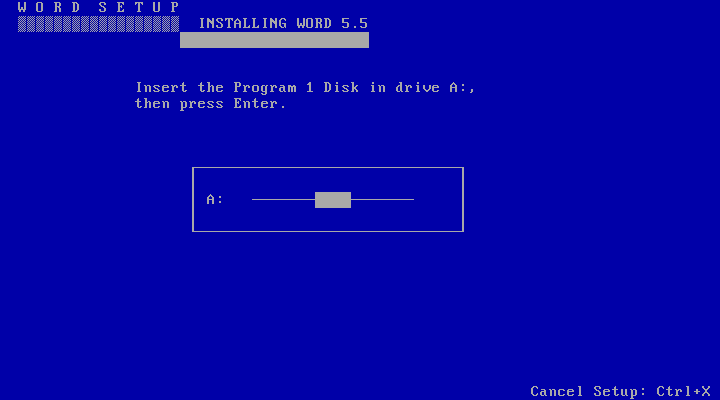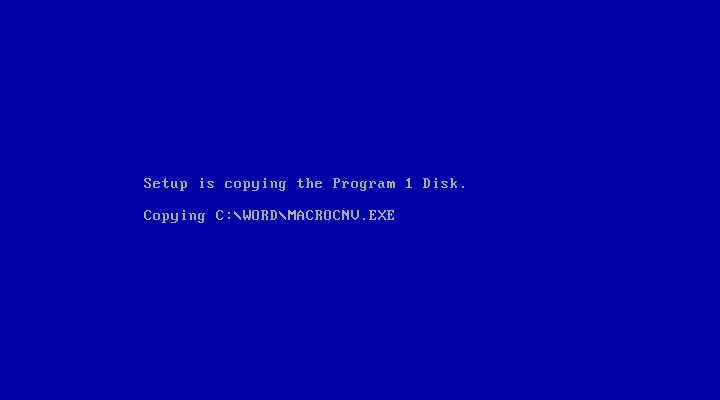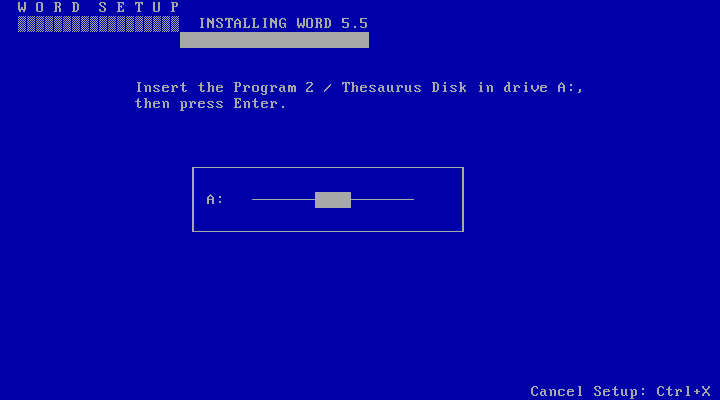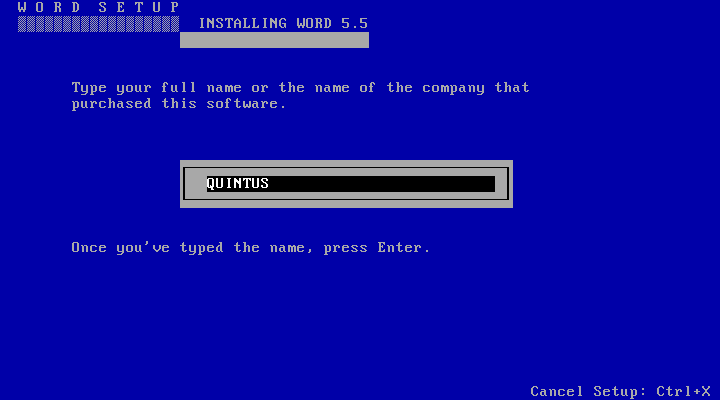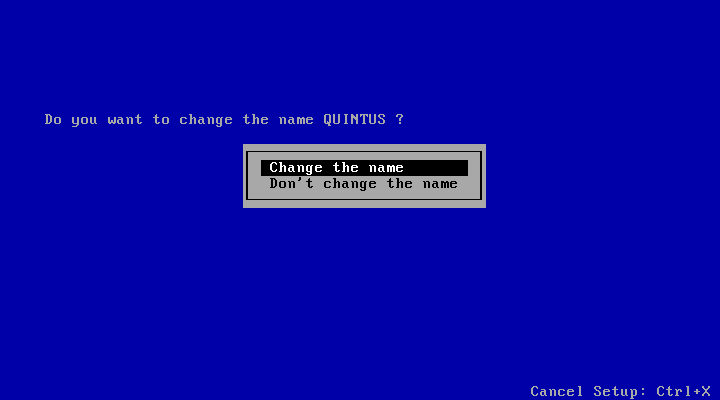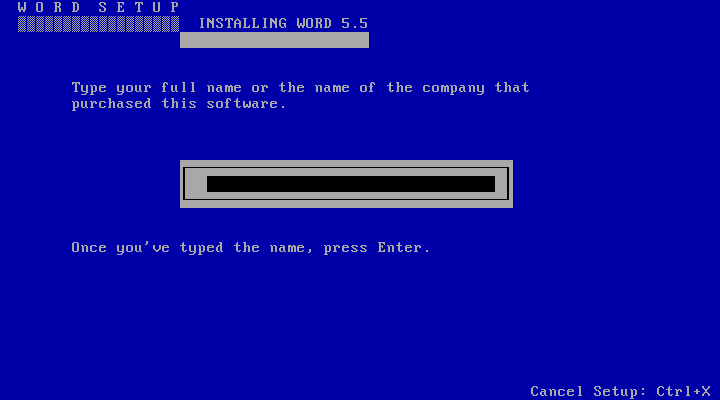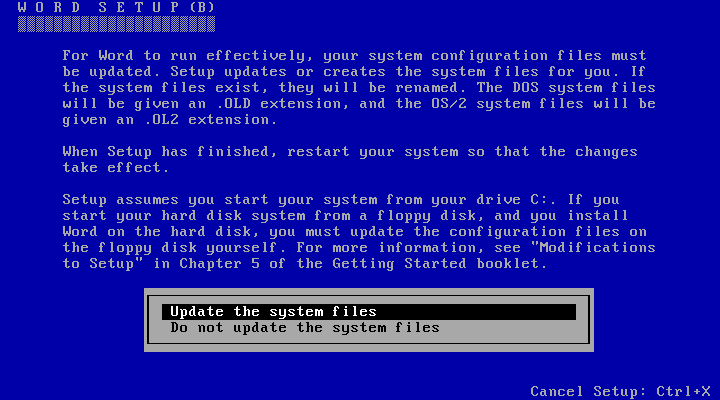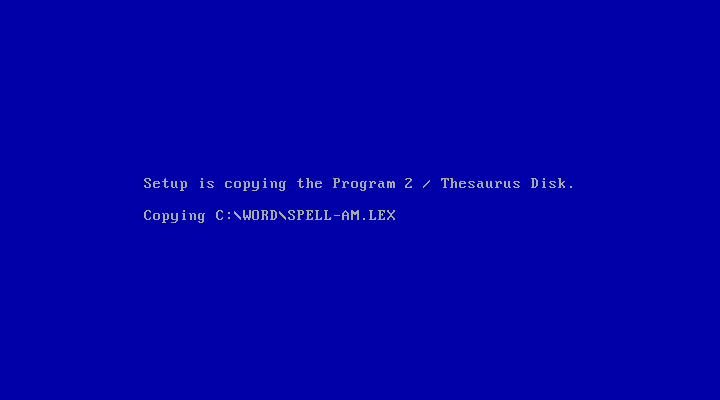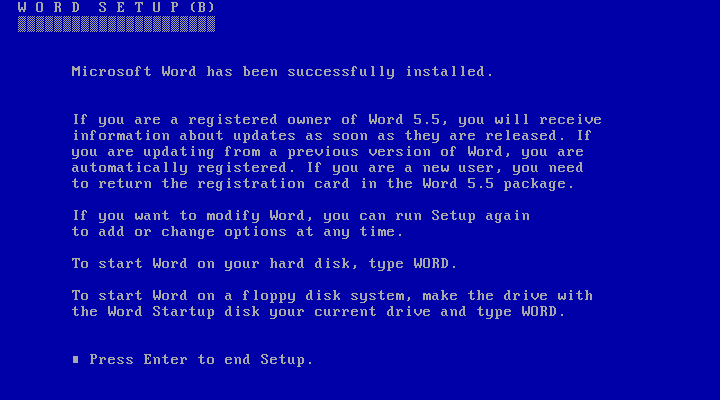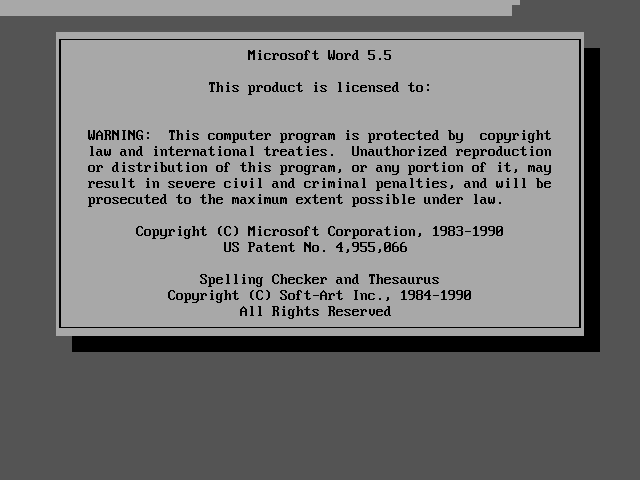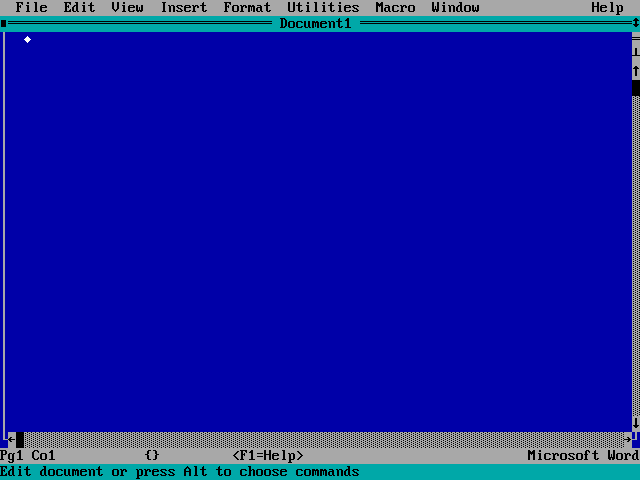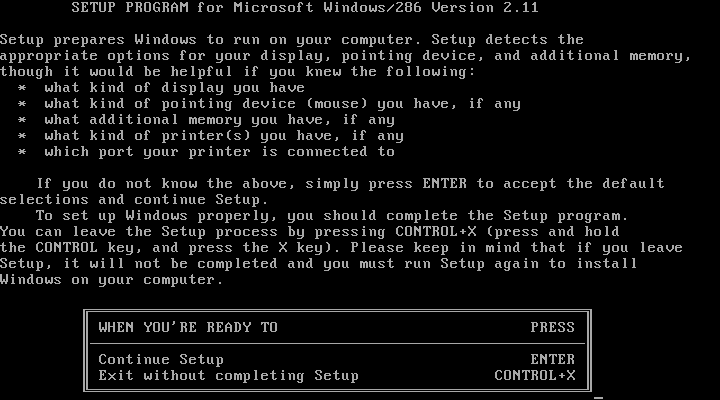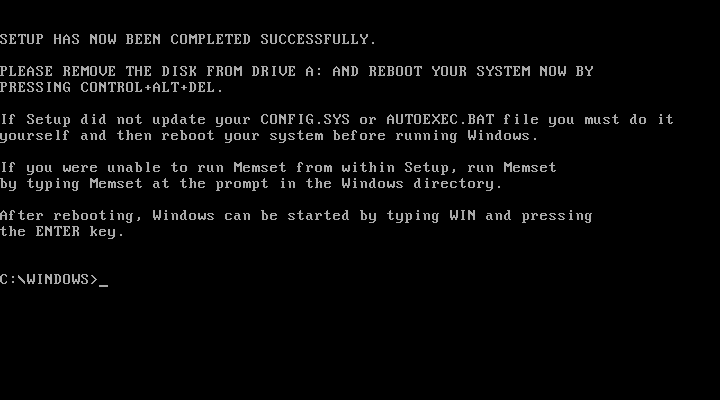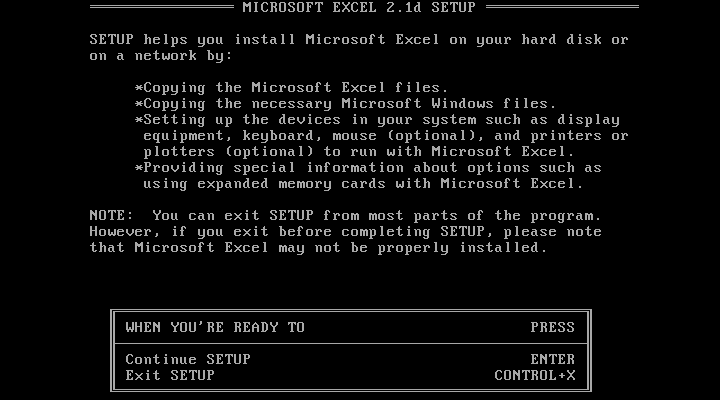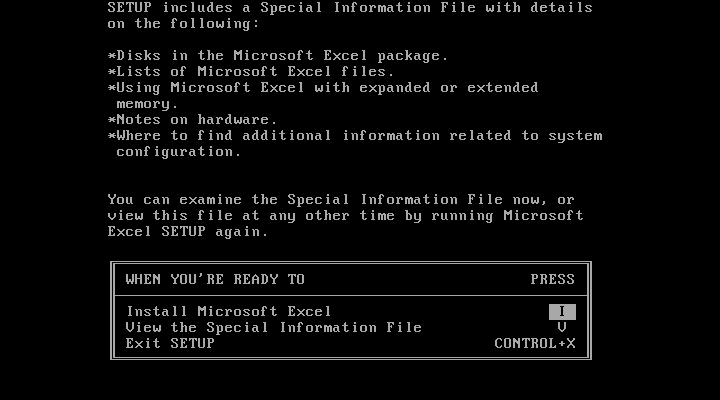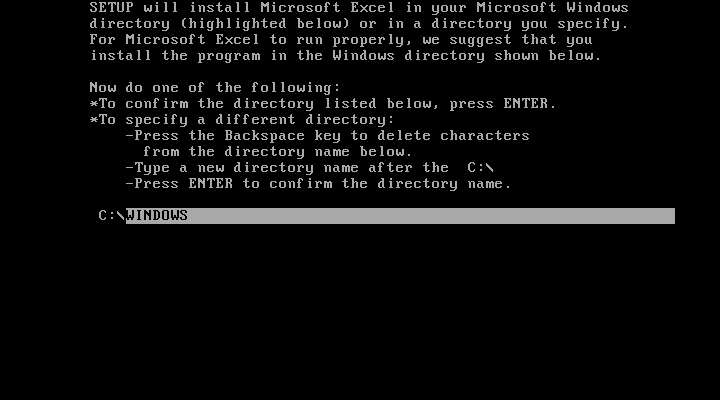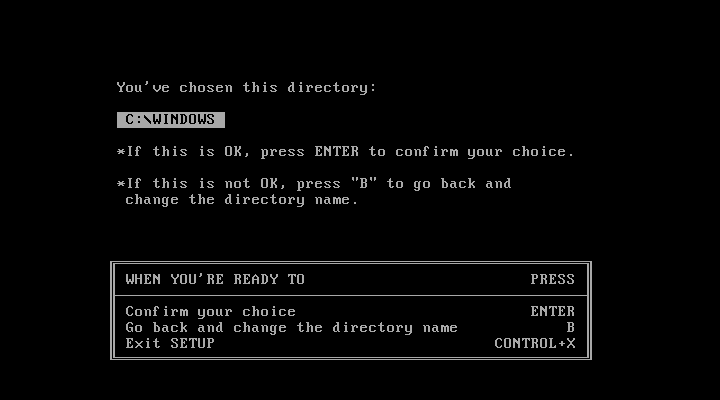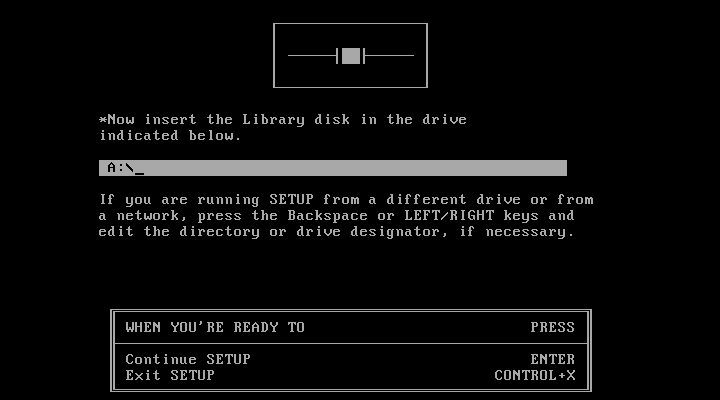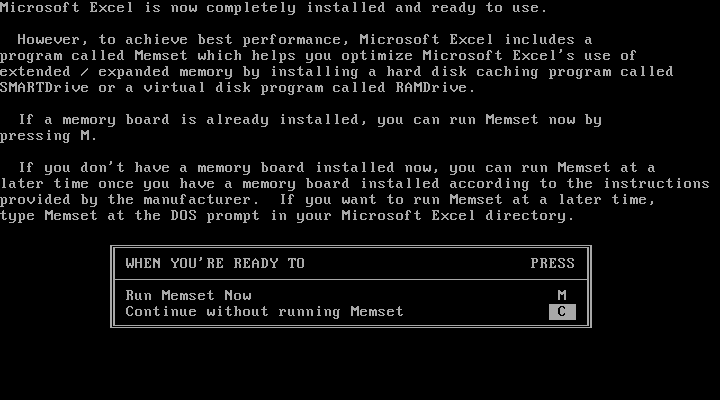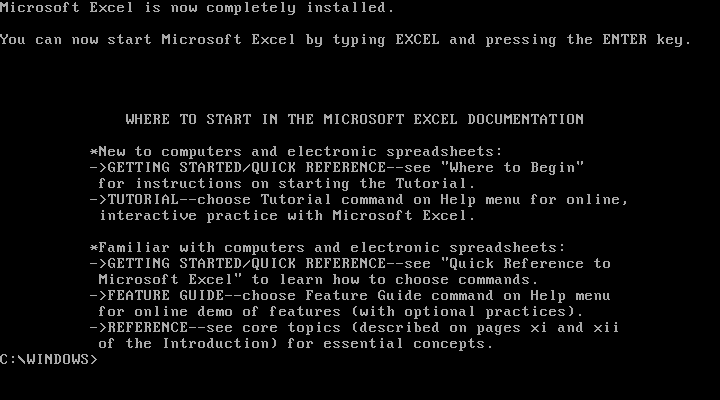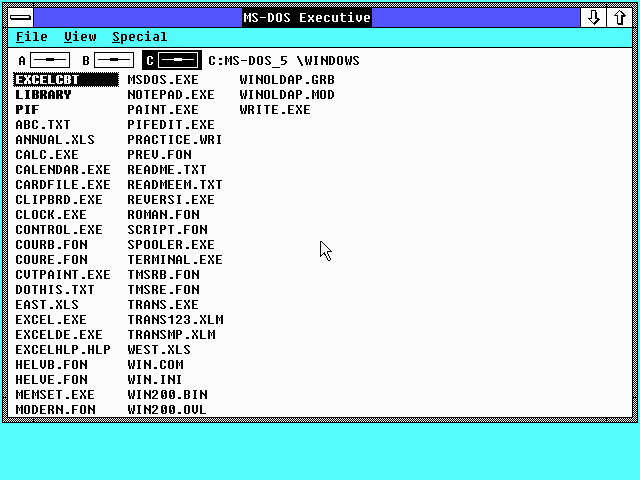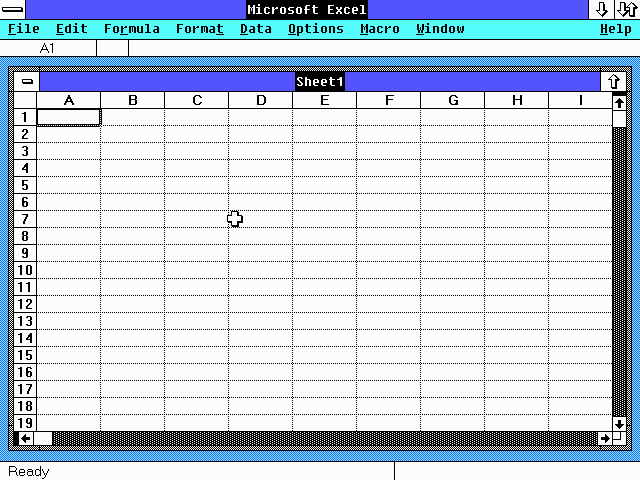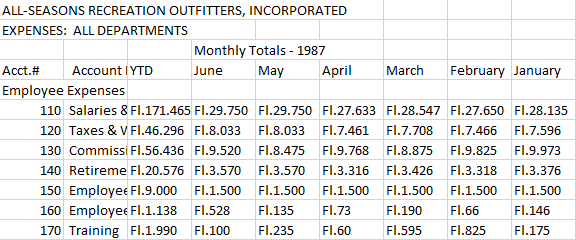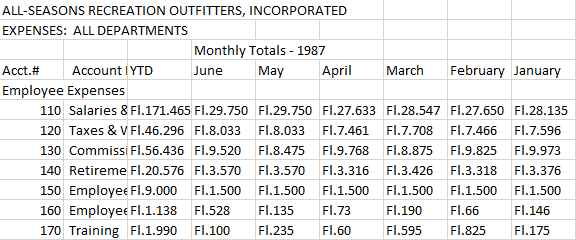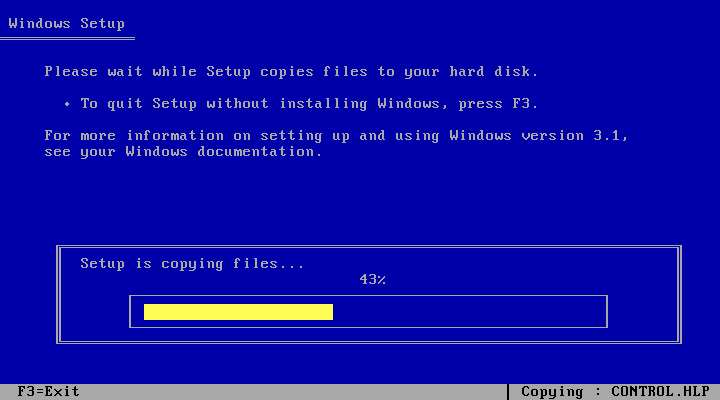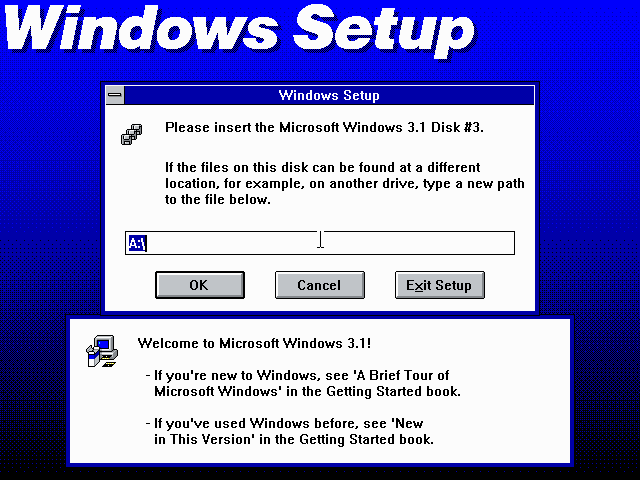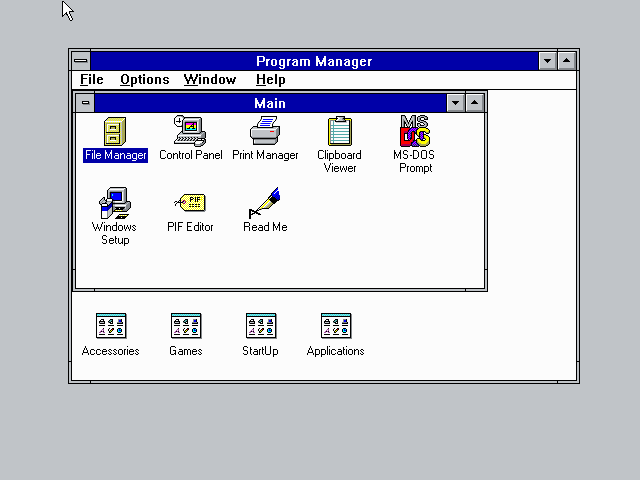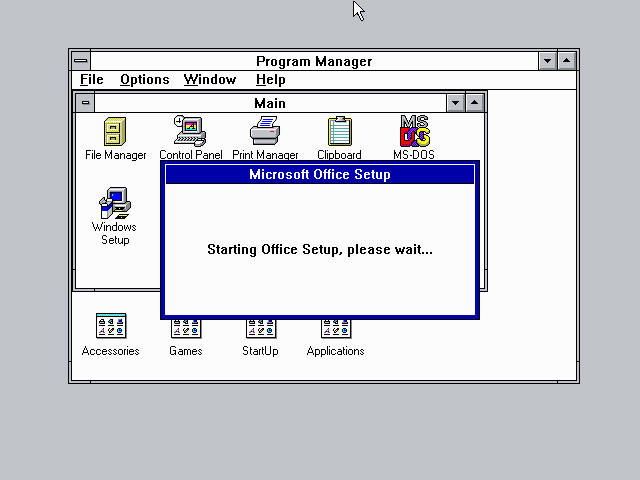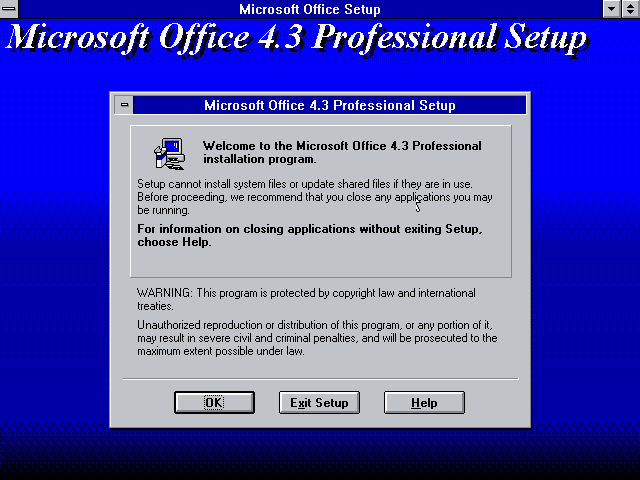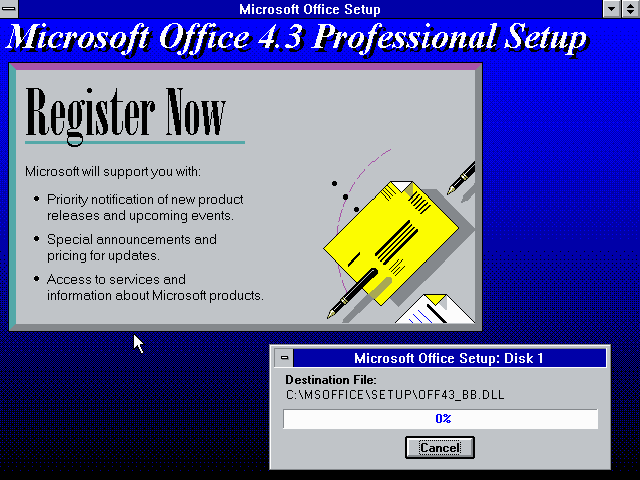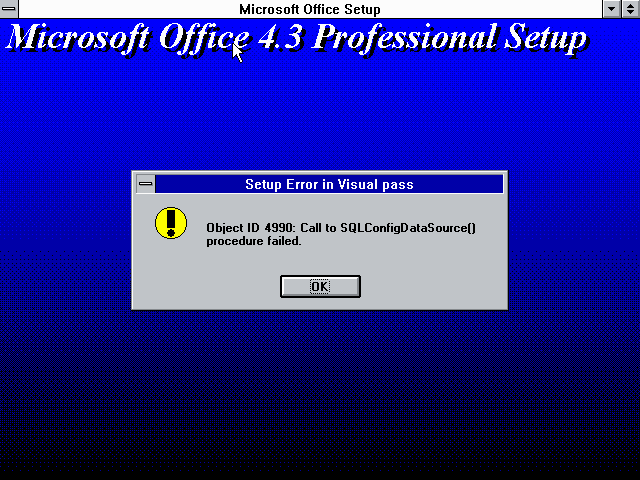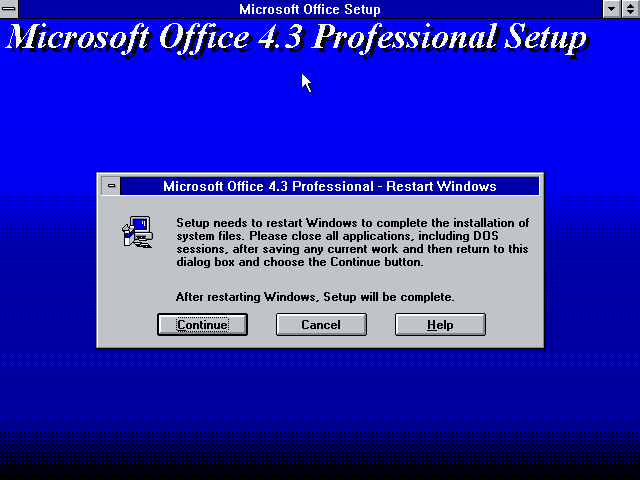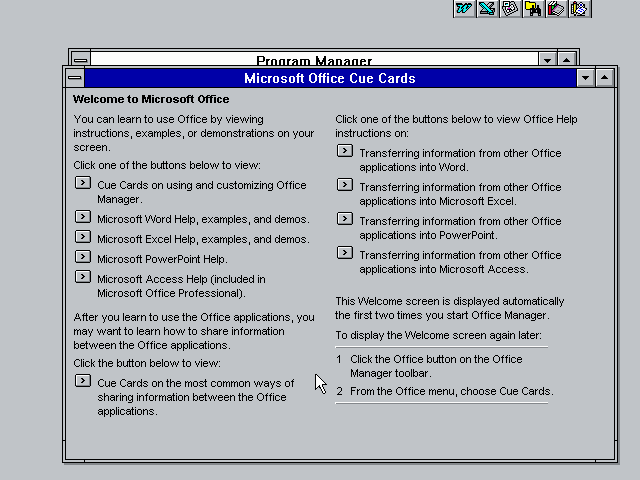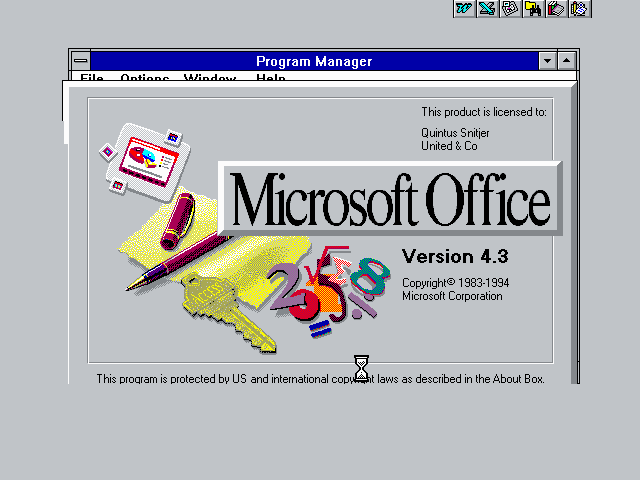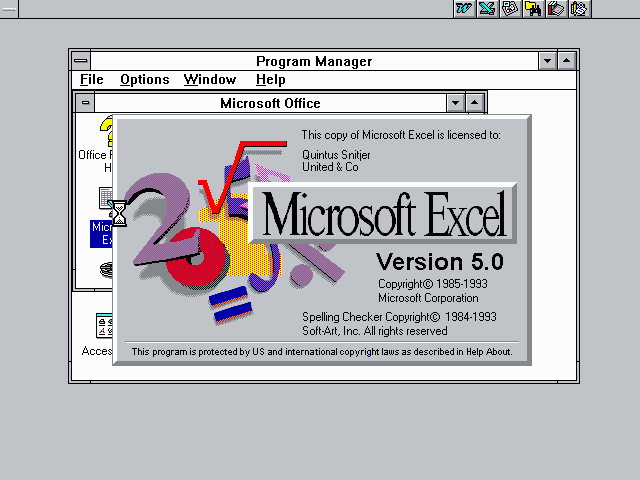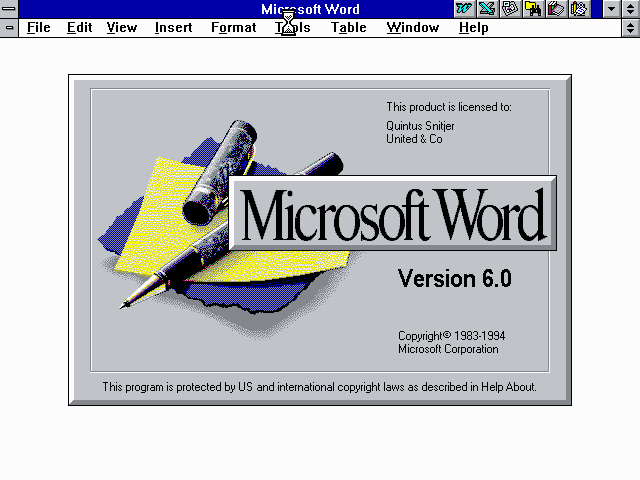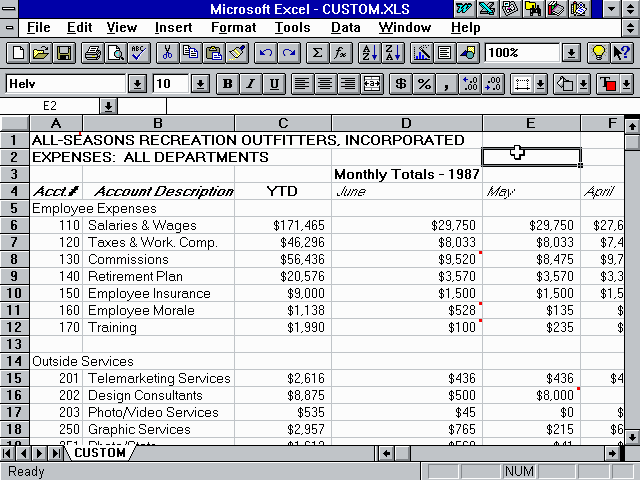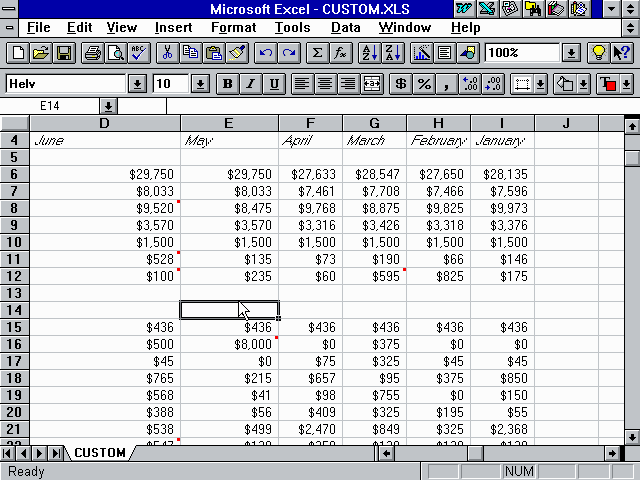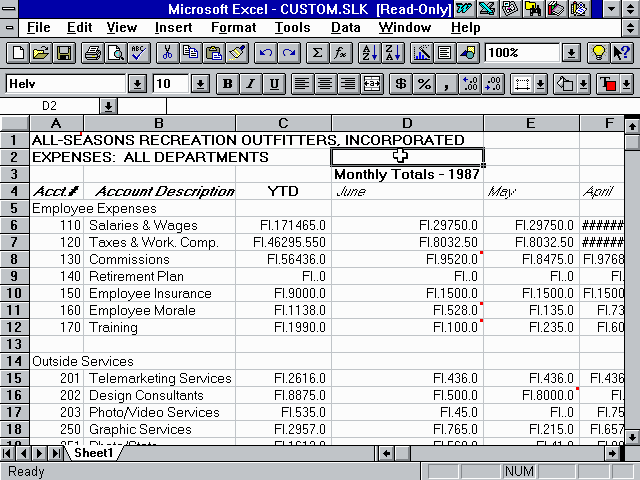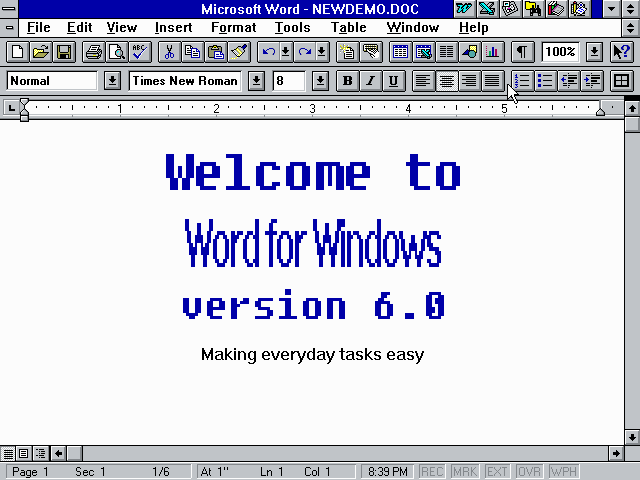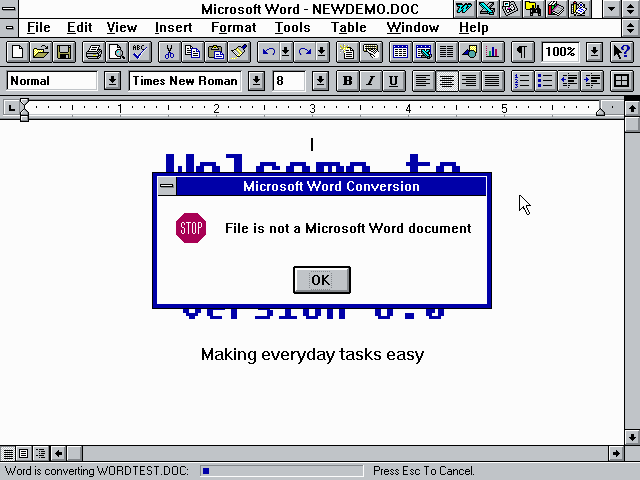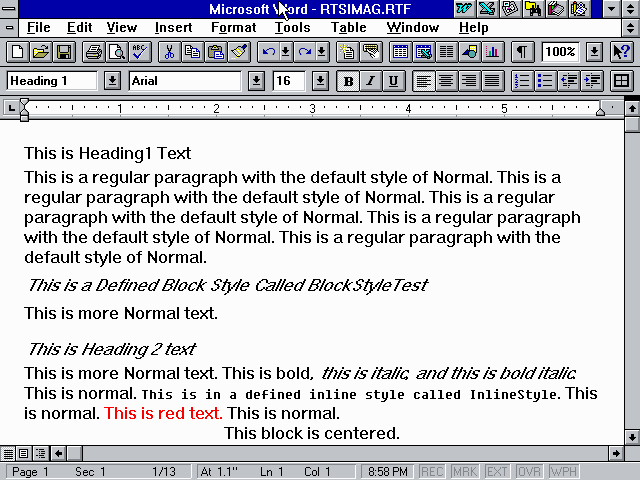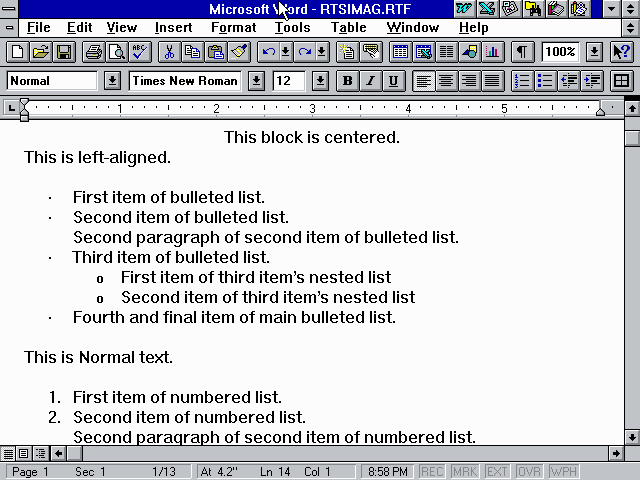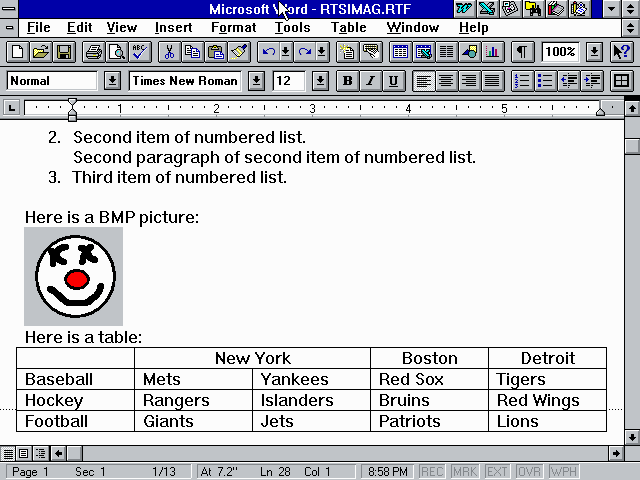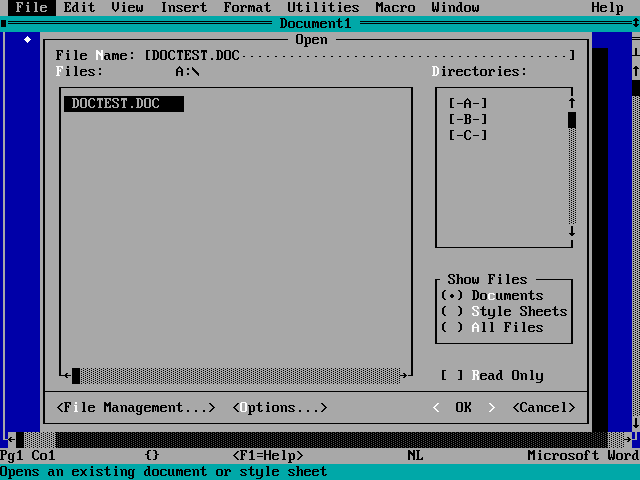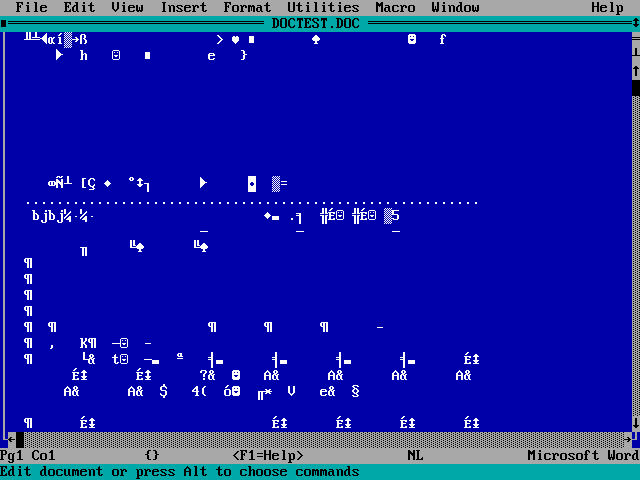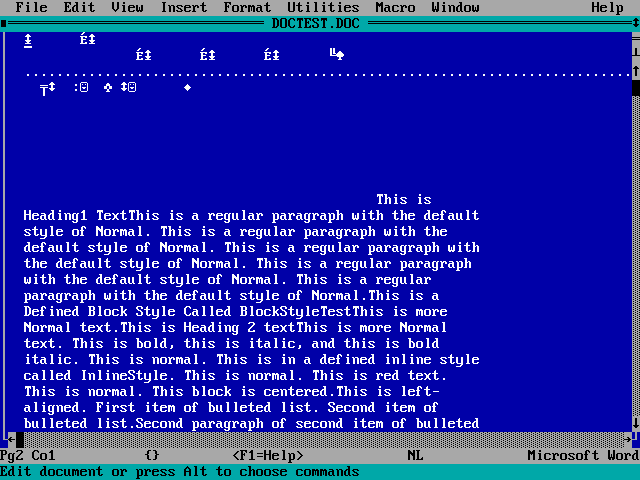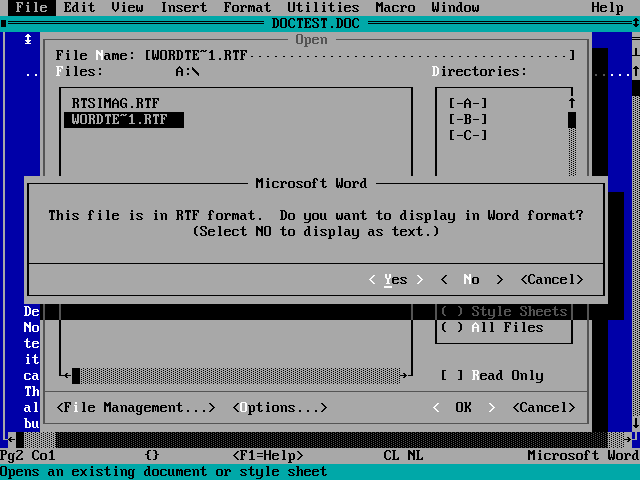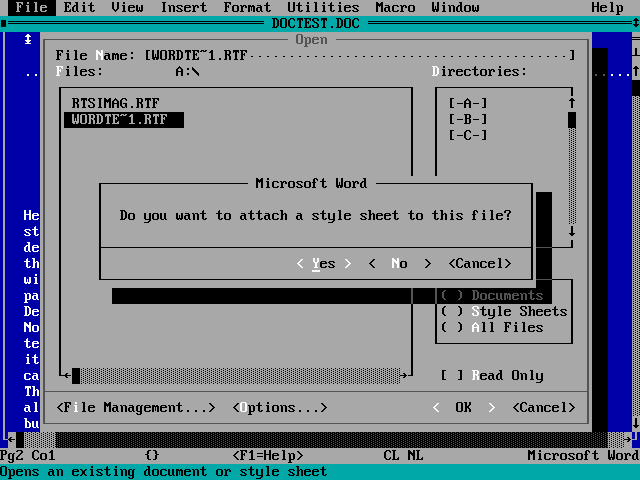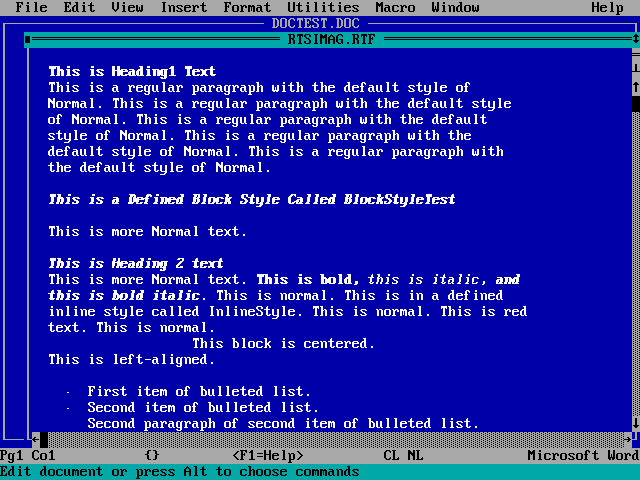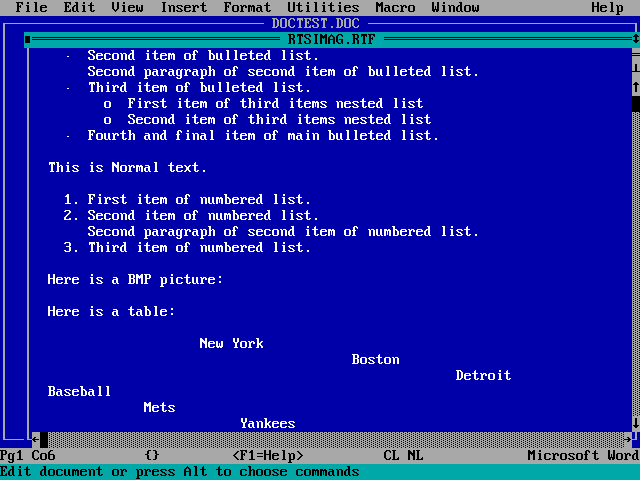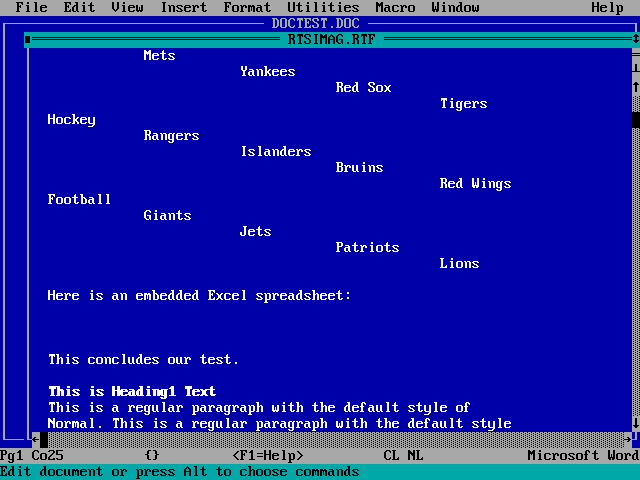Today we strech compatibility to the maximum, taking a system with processing from 1978 and taking it to the modern age in Word and Excel.
Introduction:
Microsoft Excel and Word are well known, but did you know they date all the way back to 1983 and 1987?
Originally made for Microsoft DOS, they were fully text based and were not able to do any graphics what so ever.
Of course that changed with the rise of Windows and OS/2 by IBM. Both getting their own respected versions of Word and Excel. Early Macintoshes too!
So how far can we take this compatibilty, if we keep our system limited to the original Intel 8086 processor from 1978?
Note: Don’t want all the steps taken and just jump to conlusions? Well then just, just to Conclusions!
Before we begin:
This article is fairly lengthy so instead of reading everything I suggest jumping to the parts that interesting you the most.
- For learning what our limitations are look at Limitations
- To learn how to install all software used and needed look at the installation guide for DOS, Word 5.5, Excel 2.1d, Windows 3.1 and Office 4.3.
- To skipping to the tests and screenshots look at Testing With Excel and Testing With Word.
- For skipping to the conclusions of our tests, jump to Conclusions
Limitations:
DOS will be text only:
DOS, aka Disk Operating System, being text only will not allow us to see our document 100% like we want it to show on paper. (That is why TrueType was invented).
We will be using Microsoft Word 5.5, the last pure DOS version of Word that will run on a system of this vintage.
It includes the RTF format, (more on that later) and the .5 nomination is due to a Y2K update and user interface overhaul.
Word 5 also has extra screen modes which can show Fonts better and offer 132 lines by 60 characters graphics modes.
Furthermore getting data off a real system of this age can get a bit tricky, the easiest way is to use LapLink data transfer or if you can find a card, networking. For networking I recommended you check out mTCP.
Windows on an 8086 will be limiting as well:
Windows on an original 8086 will limit us to Windows 286, which you can find here. Thus for Graphical applications and compatibility that will limit us to a 640×480 resolution at 16 colors unless your cards supports Windows 2.
Word for Windows was introduced with Windows 2 so we will thus be limited to Word 1.0 For Windows.
Installations:
First we will go step-by-step for installing Word 5.5 on DOS.
You can get the installation media two ways, one is the full package Microsoft gave away back when they had an open FTP you could find all kinds of neat things in. You can find this at archive.org.
The second option is to go with original disks, but this can be cumbersome. If case you need them, you can find the disks here.
But first, MS-DOS itself. With an early processor like the 8086 it is highly recommended to go with MS-DOS 5.0 and not 6.22. MS-DOS 6 is highly optimized for an Intel 386 or higher processor and it will be much slower then DOS 5 on an Intel 8086 or 80286 processor.
MS-DOS 5.0:
So lets go by first installing DOS itself. First, be sure to have disks handy with DOS on them if you are running a real system. Otherwise emulating with software like PCem will simply need the disk images you downloaded.
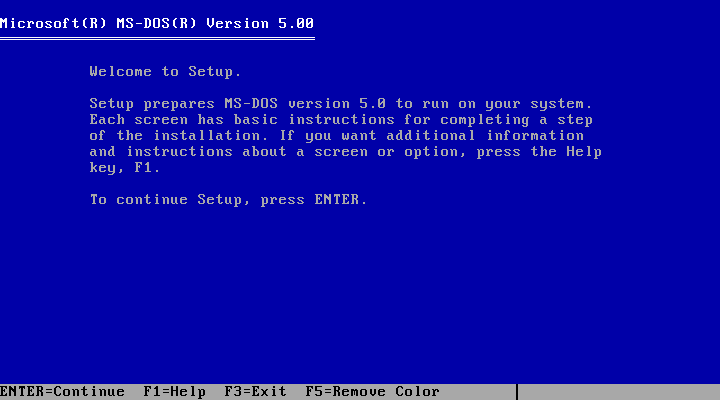
1. Welcome to setup! 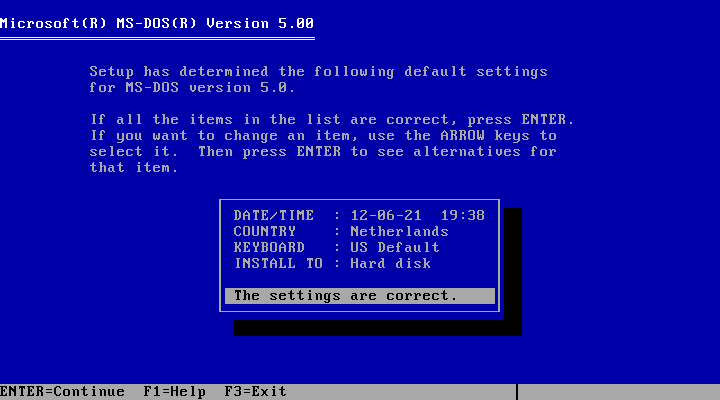
2. Select your info 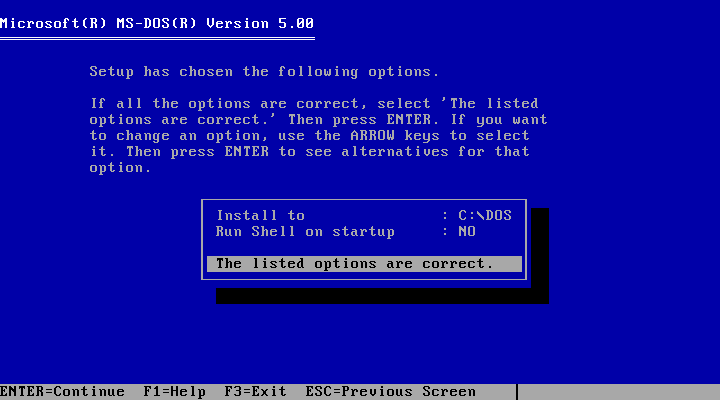
3. Do not run shell 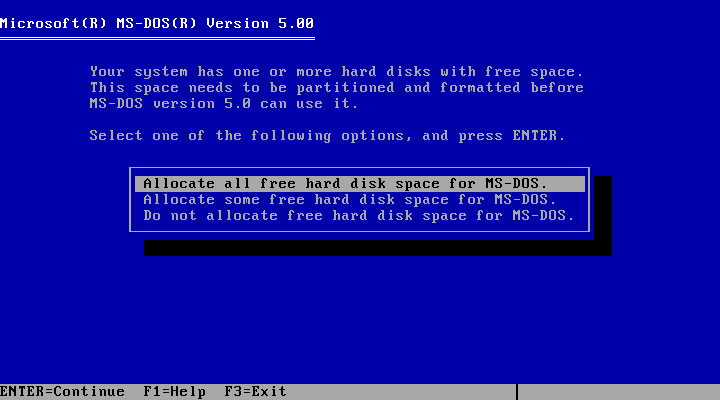
4. Format the hard disk 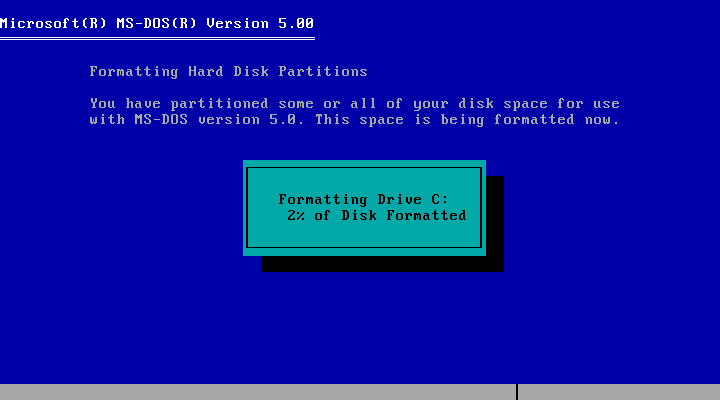
5. Formatting.. 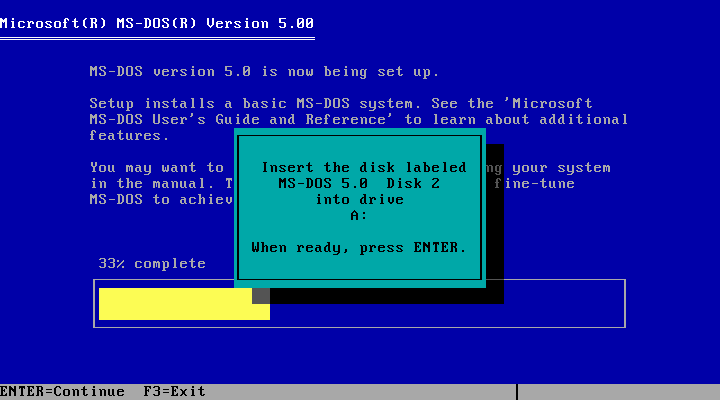
6. Insert the next disk 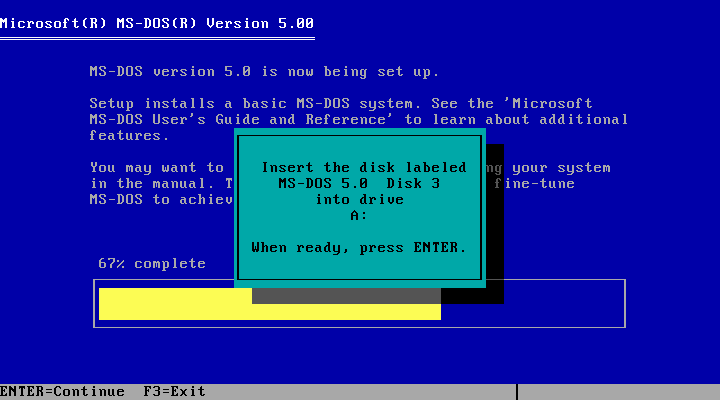
7. And the next 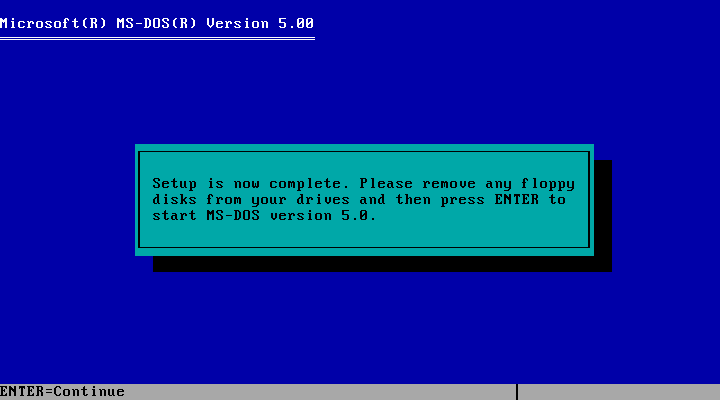
8. Done! 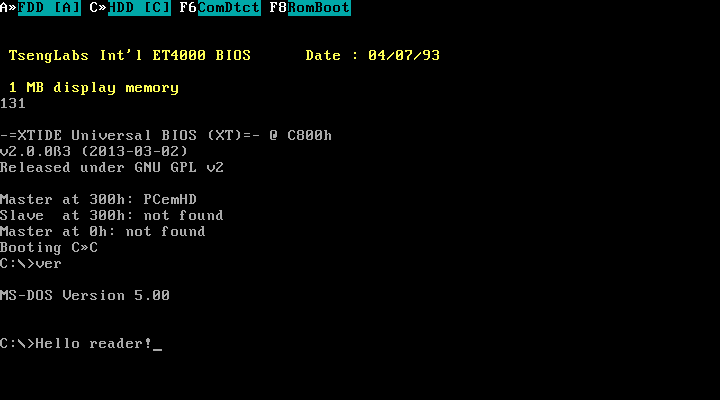
9. Welcome to DOS
- 1.
With your disks loaded DOS should now start up and greet you. Hello! Press enter to continue. - 2.
Insert your info like the date and time, plus your location. - 3.
Disable shell if you want, it is a ‘graphical’ interface that is to help with file management. - 4.
If your disk is ‘new’ it will ask you to format. Unless it has data on it you might want to look at that first and see if it is worth saving. Otherwise not, exit out of setup with F3, run “format C:”, let it finish and return to “setup”. - 5.
Now we wait for the disk to format if you did not do that beforehand. - 6.
Screenshot 6+7: Now DOS will start to install itself to the harddisk and copy the software from your floppy disks. - 7.
Congrats! Press enter to restart your computer as the installation is finished. - 8.
And after a reboot you should now be greeted with the “C:\” prompt. Welcome to DOS 5!
Word 5.5:
Now that we have DOS installed to start our productivity setup, we will now move on to Microsoft Word 5.5.
In this small guide we will be using disk copies as well just like in DOS’ installation process. Unless you picked the version off archive dot org, in which case run that, let it unpack itself and run setup. Now follow along:
To begin, insert the Setup disk into the computer or emulator.
Starting setup:
To begin setup, run “setup” on the location where the files were unpacked, or where your floppy disk is. Push enter twice to skip the welcome message and select “Set up hard disk” to begin installation.
Now select to install a new version of Word, choose a folder to install to and accept the “100% Compatible PC” option for your system.
The same goes foe the video adapter, the compatible option is just fine. (Unless your hardware has something else of course.). We will not install the printer drivers by default, unless you need them then select yes and follow the instructions. Then accept the spell checker, as it can always help.
Same goes for the thesaurus, as I myself do use it to look up words once in a while. We do not need Word lessions, as the new interface is fairly straight-forward to use. (But you can choose otherwise). A mouse is highly recommended so if you have one or can have, select to let Word update the mouse driver.
Set up your settings:
Now select to Customize Word settings, we we will set up a couple extra things. We will first run Word in graphics mode, as this will help with Fonts and the user interface. (Will not work on MDA graphics adapters!) Word 5.5 function keys are good.
The Overtype function is for the Insert key. What this does is when Insert is enabled, you type and replace text in a sentence instead of moving the text to the right. This can be helpful in lets say, fixing a typo.
Then for graphics, answer what you see on your screen. In my case it was the default option.
Lastly for paper size I will need A4 paper, whereas you might have a different format. Answer accordingly.
Installation begins:
Installation will now begin, insert the disks with the naming Word asks for and the PC should beep when it asks for a new disk. Floppy goes nomnomnom.
After copying the first couple disks, Word will ask for your name. Enter your name, press enter and select “Don’t change the name” after you are done. If you select Change the name you will get the prompt again.
NOTE: This name will show up every time you open Word!
Almost done, select Update the system files to make changes such as buffer sizes and the mouse driver in DOS. The last disks will now copy and the final setup message will appear.
Setup complete!
CONGRATS! You can now exit setup, use the “CD” command to change to the word directory, enter “word” and you will be greeted by your new Microsoft Word 5.5 installation!
Excel 2.1d:
Now before we install Excel, we will of course need Windows. The process is 99% the same as DOS’ installation procedure so write and insert the disks you downloaded and follow the setup program.
Use the “100% Compatible” PC option, VGA display, be sure to check if you have extended memory on your system. Memset is not required most of the time.
After installation you use the “win” command to start Windows.
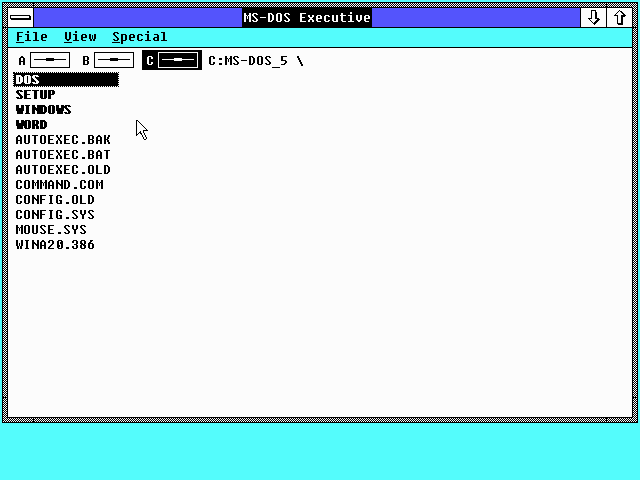
Now, on to Excel 2.1 revision D.
Setup:
To begin, change directory using CD or a drive letter with :, and open setup. For most of setup unless you want to change anything you can just push enter to continue with default settings.
As usual, insert the next disk and push enter, the computer will beep once a disk is done.
And done! Excel is now in the WINDOWS directory, ready to open. Use the “win” command again to start.
Starting Excel:
And as usual, after the Windows ‘desktop’ appears, grab your mouse and double-click on EXCEL.EXE, wait for it to start and tada!
Excel 2.1 revision D, ready to go.
Testing with Excel:
Now the point of all this, is to see if 34 year old software, (as goes for Excel) can still be read by modern Office and how well. If not, what export format works the best?
Excel 2.1:
For Excel’s save as feature it supports the following formats: XLS, TXT, CSV, SYLK, WKS, WK1, DIF.
Excel can also open and edit these files on the fly so they count as testable. Thes files themselves are:
- TXT: Text
- CSV: Comma Seperated Value
- SLK: Symbolic Link
- WKS: Microsoft Works
- WK1: Lotus 1-2-3 Spreadsheet
- DIF: Data Interchange Format
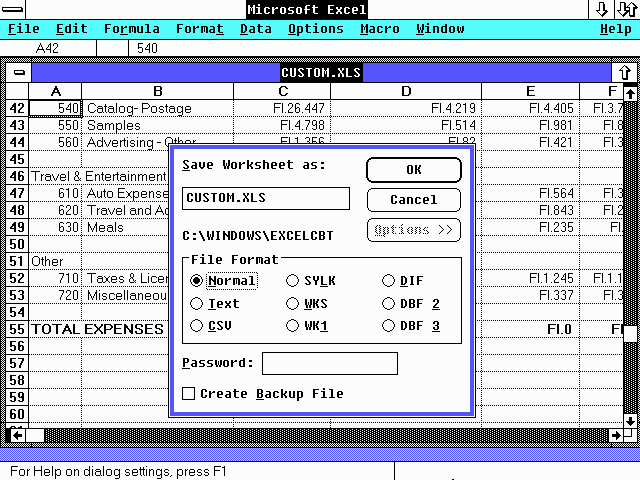

First, we will test the files in Excel. Screenshots are default results with said format.
From Windows 2.03 to Office 365:
TXT & CSV:
CSV and the TXT file are both guaranteed to work, the CSV uses the comma to seperate cells in a spreadsheet, and the TXT files use tabs to indicate next cells. BUT, they only store the base values. Not the formulas used to calculate.
Opening the TXT files in Excel will bring up a menu asking what format it is in, by default it does notice the tabs, and continuing with the default options it give you it does split cells properly.
DIF:
Next is DIF, Data Interchange Format. A format designed to be compatible across software, no matter what you were using. This file format also seems to read just fine but again, does not contain any formulas. DIF opens correctly in Excel but not in OpenOffice.
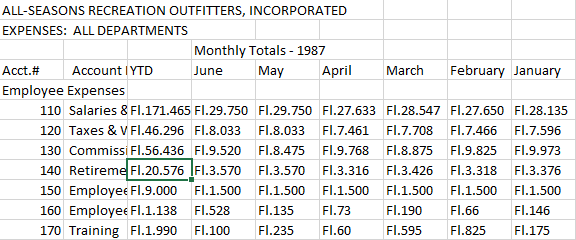
SLK/SYLK:
SYLK, Symbolic LInk. I remember using this file format back in school because yes, this format does read just fine and keeps formulas in place! Now there were 6 errors reported while reading the file, but the calculated data and formulas are in place. SLK even copied the font styling!

WK1:
The file format for Lotus 1-2-3, one of the most used software and well known names from back in the day. As you can see, this one defaulted to open with OpenOffice and does contain formulas. It also kept the spacing for each row I put in! Excel failed to read this format at all.

WKS:
Microsoft Works, where one file format was used for every software tool it had to offer. Database, word processing and spreadsheets in one. Ironically, Excel does not read it at all! OpenOffice on the other hand reads it just fine, exactly the same as WK1. Only fonts did not get copied across.

XLS:
And the kicker, does Excel itself read a 34 year old XLS?
Yes it does! Row spacing, text fonts and formulas are all here and just like they should be.

Points/Who won?
So point wise, if you were to count all the features each format had correct, who are the winner?
Counted were cell data, formulas, fonts and row spacing.
- TXT: 2 out of 4.
- CSV: 2 out of 4
- SLK: 4 out of 4.
- WKS: 3 out of 4.
- WK1: 4 out of 4.
- XLS: 4 out of 4.
I personally did not get great results with XLS back in 2017, but that seems to have been solved to a degree. In out of the box experience, XLS still wins. After that is SYLK which does great but needs a little tweaking to work right in the modern Office. So, what if you transfer a modern Excel file to Windows 2.03? Lets see.
Office 365 to Excel 2.1d:
Now to compare Excel sheets, we will use my benchmark results from Windows XP vs Vista vs 7, what to run for retro games?. It is a big file with many calulations so it will an appropiate test of export.
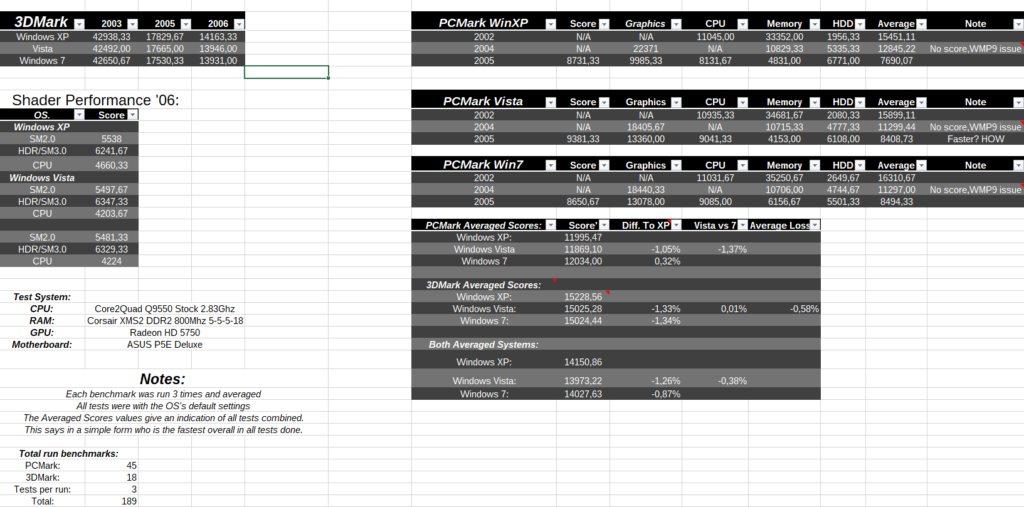
So here is what that file looks like originally, now this contains tables, formulas using said tables, combined cells and many difference calculations. Using the SLK and XLS export, how do they hold up on Excel 2?

To save in XLS, the table forumlas were converted to cell refenced and table styles where removed. All other types of data were saved and should display. So:
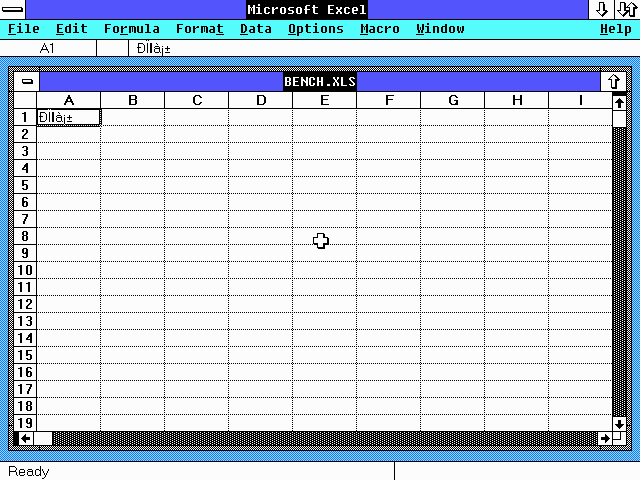
XLS just, broke. 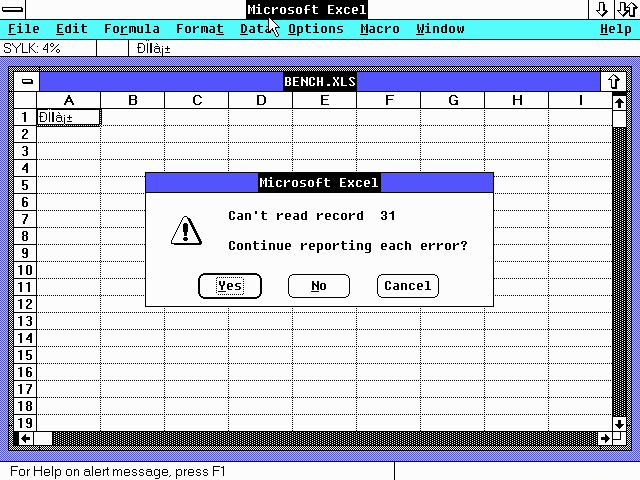
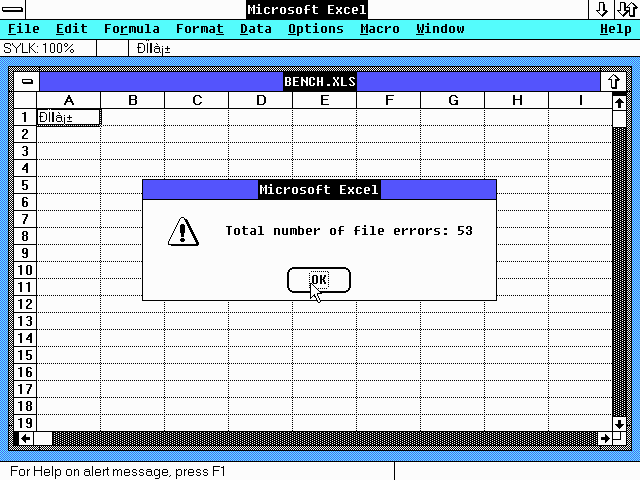
SYLK was making Excel suffer 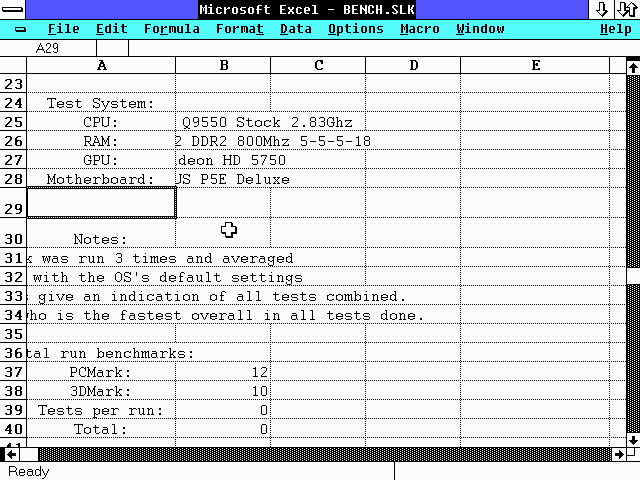
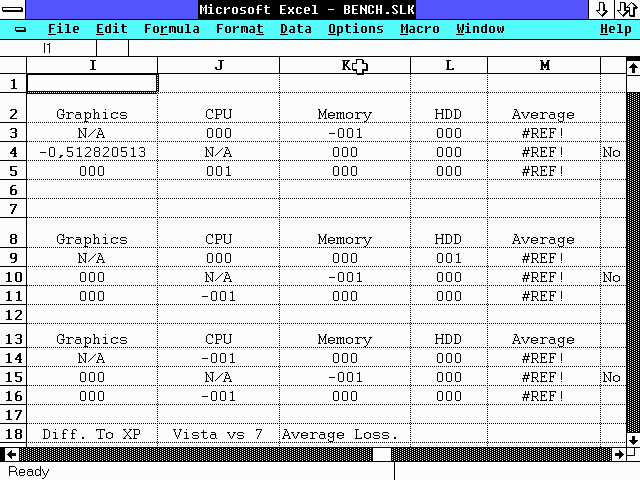
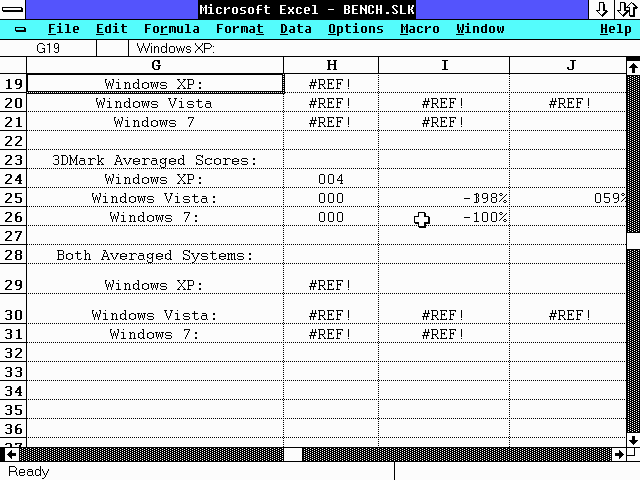
And no, everything went wrong. The two best contenders did not go well at all. SYLK had reference errors and completely wrong values, and the XLS file that seemed to promising just resulted in some garbled text.
Sad! 🙁
But Word might work better, we shall see.
Note: WKS and WK1 format had export errors, even on Excel 2’s demo files. That’s interesting.
Note 2: Excel 2 allows for saving in “DBF”, yet saving in this format always fails.
Office 4.3 to the rescue?
Now we failed to run Excel well on an 8086, but! Upgrade to and Intel 286 and there might be hope.
This is in the form of yes, MIcrosoft Office! For Windows 3.1 in fact. This has much, much better software support so might work way better.
Windows 3.1:

Running on the poor old Intel 8086 stops here, but the Intel 286 from 1982 can help in this case. It is still really old and the minimum requirement for Windows 3.1 as listed above.
While it will work, it is god-afwully slow and is NOT a recommended experience to go through. That said, lets do it anyway! It took 6 minutes for just the setup to start while at 16Mhz from floppy. The setup would be unbearable so we set to 25Mhz. That should help at least a little bit. At 25Mhz starting setup took 4 minutes, but I also changed the RAM to something faster. To save overall time, a CD was used instead.
Office 4.3 Professional:
The usual goes for setup, start it, follow the on screen instructions and what you want installed. Insert the next disk when it asks you to and soforth. Access was excluded from this installation.
The full installation from CD took 15 minutes to complete, so could be worse.
And done! We now have Excel 4 and Word 6! All that running on our 1982 processor. Impressive right?
Installation complete!
Now that our Windows installation and Office setup is done we can test if Excel 5.0 for Windows fares any better with the SLK and XLS files. So, does it?
More testing:
So, Windows 2.03 and Excel 2.1 completely failed our newer files test. Now, lets see if the newer Excel 5.0 fares any better.
First, the older files. Office 4.3 outright asks you if you want to use Lotus 1-2-3 help tools and WordPerfect help so yes, the older XLS and SLK files we saved worked just fine.
XLS files read perfectly coming from Excel 2.1, and so does SLK. SLK even has the same #### issue that indicated the value did not fit on the row. You will have to resize it a bit to show the values.
New files, versus Office 4:
Now the kicker, does Excel 5.0 read our new files properly so we can theoretically work on our files anywhere we go??
XLS did not even want to load, it came up with a format error as shown in the gallery below. But, SLK…
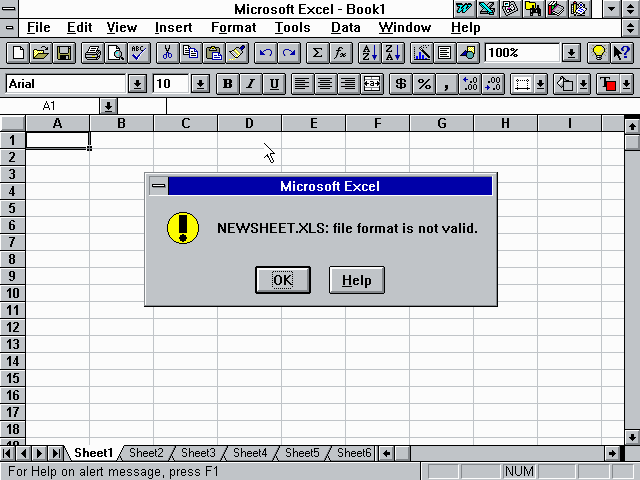
Aw heck. 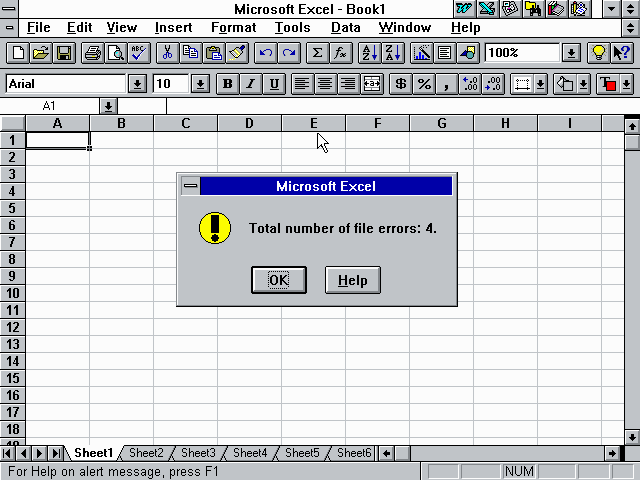
Oh that’s not too bad! 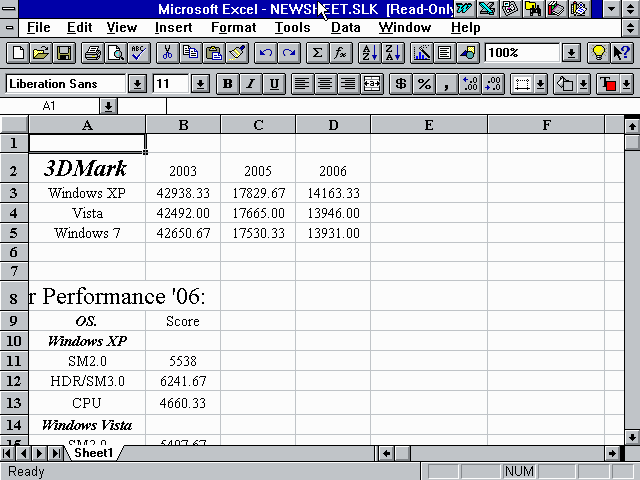
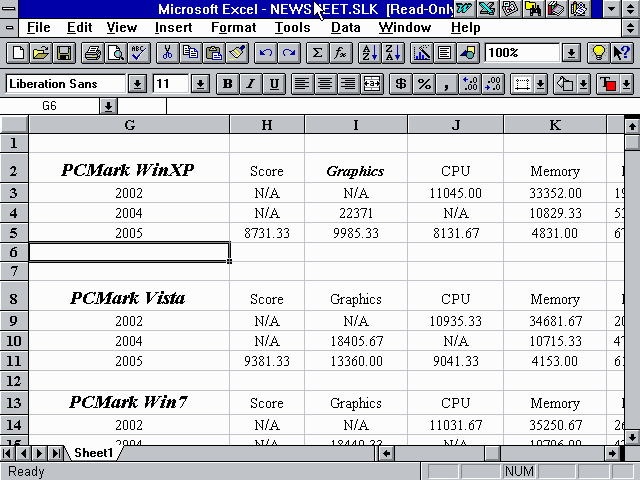
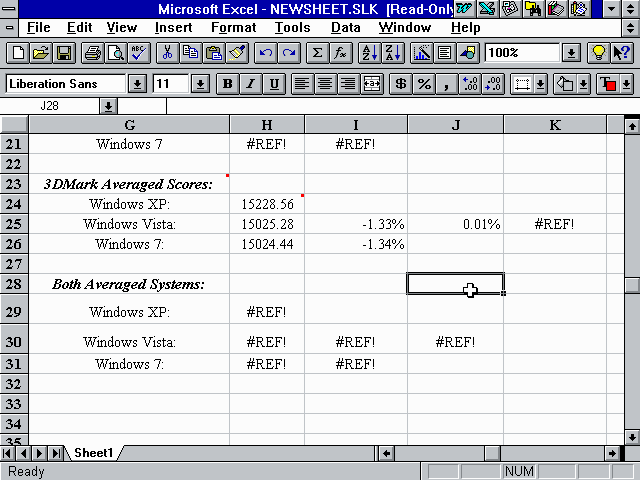
Check it out!!! SYLK is working! Fonts, column spacing, values, percentages. Only some reference errors because the only thing that did not end up working where combined cells to center text.
But IT WORKS, it works! We got a modern Excel sheet to load on an operating system from 1991, on a processor from 1982! It is exactly how I remember, where in high school I took an old Compaq Armada running Windows 3.1 with me and I saved my files in SLK, and it still holds up today! How cool is that.
Testing with Word:
By now you have probably seen all you need to understand how we test things.
For word we want to test out the most used features. We will use the 100KB test file from https://sample-videos.com/download-sample-doc-file.php. It includes:
- Headings.
- Normal paragraphs.
- Fonts and colored text.
- Text centering, left and right aligning.
- Bulleted lists with nesting.
- Numbered lists with second items.
- BMP Picture
- Tables
- Embedded Excel sheet
These will thus allow us to test the most used feature and determine which will work or not all depending on our format.
(Not pictured: Embedded Excel sheet)
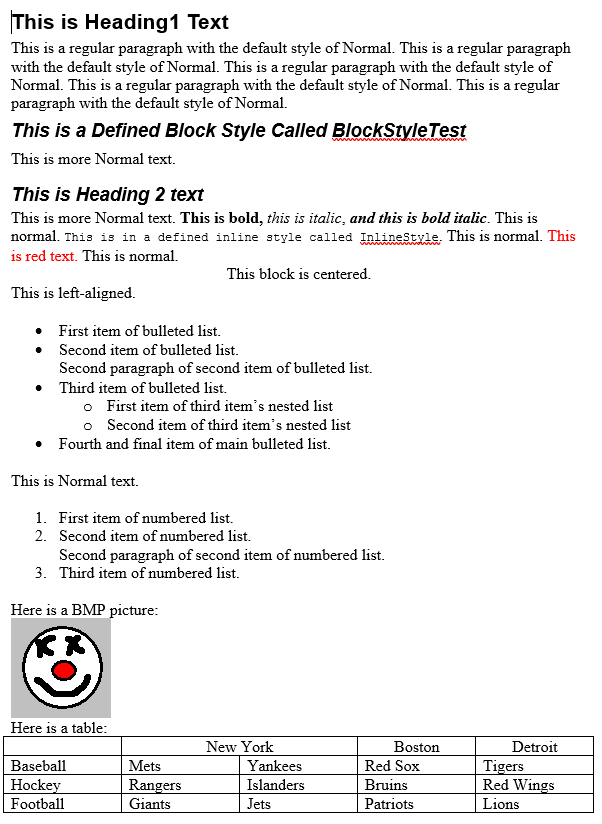
Word 6.0:
But when we try to load a DOC file from Office 365, Office 4 just says nope I dont know what this is and craps out. Well then.
An RTF documents is a bit slower seen Word 6 first converts it to, probably a DOC format. RTF supports all the same features we want to test. So what does Word 6 make of it?
Check it out!
- Headings? Yes!
- Text style with color, yes!
- Nestled bulleted and numbered lists? Yes!
- PIctures? Yes!
- Tables? Yes!
- Excel sheets? YES!
Word 6 in RTF scores on all but headings! Excellent work with compatibility, Microsoft 🙂
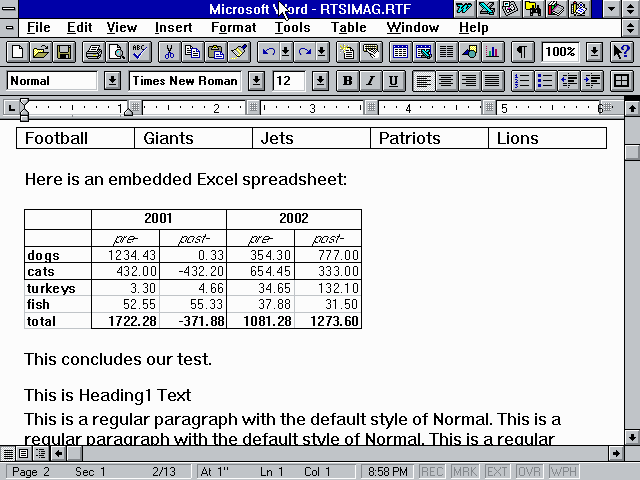
That said, there is not a real quick difference to notice what a Heading is and what it is not on Word 6. One way to notice is that when you actually add a Heading, (right click > Heading Numbering, choose a style and click OK) you cannot actually click on it and edit it like a normal piece of text.
Now to see if they are headings, you can add a table of contents to the document. Click on Insert > Index And Tables > go to Table Of Contents, choose your style and click OK! Your table of contents will now be processed and added.
My take? Word 6 is a perfect option for running new documents on DOS systems.
Word 5.5:
Now with Word 5.5 come a couple things to not first:
- Fonts will not display immidately but only on paper or the paper previeuw.
- Excel sheets are of course, not supported.
That being said, does DOC load well?
Sadly no, it does not. Upon loading our test document Word does not ask what file it is, and seems to fail to identify the file at all.
What you see here is what the file looks like if you were to turn all data into text directly. Lots and lots of random garbled data!
So, RTF, Rich Text Format worked well in Word 6. Does Word 5.5 fare the same?
When loading an RTF file, Word will first ask if you wish to display it as a Word document, answer yes. Furthermore it will ask if you want to attach a style sheet to the file. In most cases you will not need to do this.
RTF overall fares MUCH better, so what do we see here, this is the exact same file we just loaded into Word 6.
- Headings? Maybe?
- Text style with color? No
- Nestled bulleted and numbered lists? Yes!
- PIctures? No!
- Tables? No.
- Excel sheets? No, but we knew that it would not be possible.
Word 5.5 is very plain, it does not seem to allow colored text, (maybe set up a color printer first?)
Tables do not show or seem very broken, Pictures are not supported either.
So this gives Word 5.5 a very basic experience, it is not perfect but for what it can do it does ‘well’.
But the biggest point for Word 5.5 is that it DOES run on the Intel 8086 we set out to challenge. It will run on practically any PC that is IBM compatible! Whereas Word 6 needs an Intel 286 or higher to run at all.
Conclusions:
Now, we set out to run Word and Excel as best as we could on an Intel 8086.
It did not go as planned, and the following things happened and were found:
- Excel 2.1, Word 6 and Word 5.5 all fail to read their new XLS and DOC formats. But SLK and RTF work perfectly fine.
- Word 6.0 worked spotless with RTF documents, all things we had tested worked perfectly! But requires a processor upgrade.
- Word 5.5 run on anything but has limited functionality. If you want to do pure text in an easy interface it works just fine.
- Windows 2.11 can fail to start at all sometimes on an 8086 setup so stick with 2.03 if the same happens to you!
- Windows 3.1 and Office 4.03 on an Intel 286 is slow, but at 25Mhz not all that bad.
The gyst of it all is that yes, you can run your modern documents on an 8086 if you keep it to pure text and simple Excel sheets. If you want to full experience you will need to ‘upgrade’ to an Intel 286 processor at minimum. Otherwise, yes, you can process your documents (sort of) on an 1978 processor!
Thank you so much for reading and have a nice day!

